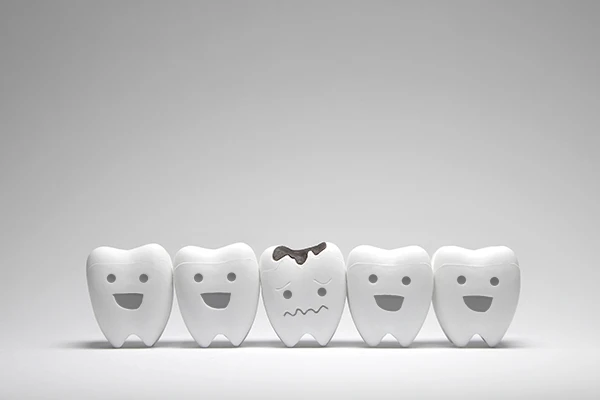The Different Stages of Tooth Decay and When to Seek Treatment
 Tooth decay is one of the most common dental problems affecting individuals of all ages. By understanding the stages of tooth decay and knowing when to seek treatment, you can protect your oral health and prevent costly and painful complications. In this guide, we’ll walk you through each stage of tooth decay, from the earliest signs to advanced cases, and provide actionable tips for prevention and treatment. Tooth decay is one of the most common dental problems affecting individuals of all ages. By understanding the stages of tooth decay and knowing when to seek treatment, you can protect your oral health and prevent costly and painful complications. In this guide, we’ll walk you through each stage of tooth decay, from the earliest signs to advanced cases, and provide actionable tips for prevention and treatment.
Introduction to Tooth Decay
Tooth decay, also known as dental caries, occurs when bacteria in the mouth produce acids that erode tooth enamel. Over time, this process can lead to cavities, pain, and even tooth loss if left untreated.
| • |
Global Prevalence - Studies indicate that nearly 3.5 billion people worldwide are affected by oral diseases, with cavities being one of the leading conditions.
|
| • |
Why Early Intervention Matters - Catching tooth decay in its early stages can prevent extensive damage, reduce treatment costs, and preserve natural teeth.
|
| • |
Common Factors - Poor diet, inadequate oral hygiene, and genetic predisposition significantly contribute to tooth decay. |
Relatable Example: Imagine a small cavity forming due to unaddressed plaque. Over time, it deepens, requiring a root canal or extraction—an outcome that could have been avoided with early treatment.
Stage 1 – Initial Demineralization
The first stage of tooth decay involves the loss of minerals from the tooth enamel, known as demineralization. This stage is reversible if addressed promptly.
| • |
What Happens - Plaque bacteria interact with sugars to produce acids, leading to enamel weakening.
|
| • |
Causes - Excessive sugar consumption, poor oral hygiene, and acidic foods.
|
| • |
Signs - White spots on the enamel and occasional sensitivity to hot or cold.
|
| • |
Prevention - Fluoride strengthens enamel and can reverse early damage. |
Did You Know? Studies show fluoride can reduce cavities by up to 25% when used consistently in toothpaste or treatments.
Stage 2 – Enamel Decay
If demineralization continues, it progresses to enamel decay. At this stage, small holes or pits begin to form in the enamel.
| • |
Visible Damage - Discoloration and the appearance of tiny cavities.
|
| • |
Symptoms - Pain when eating sweets or consuming hot or cold foods.
|
| • |
Professional Care - Dental sealants and professional cleanings can protect and restore enamel. |
Expert Tip: Regular dental checkups help identify enamel decay early, preventing further complications.
Stage 3 – Dentin Decay
When decay reaches the dentin, the softer layer beneath the enamel, the damage accelerates. At this stage, professional intervention is critical.
| • |
What to Expect - Yellow or brown discoloration becomes visible.
|
| • |
Symptoms - Increased sensitivity and sharper pain.
|
| • |
Treatment Options - Fillings or crowns to restore the tooth and halt progression. |
Patient Story: A patient delayed treatment for mild pain, resulting in the need for a root canal after the decay reached the dentin. Early care could have prevented this.
Stage 4 – Pulp Damage and Infection
In advanced decay, the infection reaches the tooth's pulp, causing severe pain and potential abscess formation.
| • |
Key Symptoms - Intense pain, swelling, and sensitivity.
|
| • |
Complications - Abscesses can lead to systemic infections if untreated.
|
| • |
Treatments - Root canal therapy or, in severe cases, tooth extraction. |
Important Note: Modern advancements in dentistry make procedures like root canals more comfortable and efficient than ever before.
Preventing Tooth Decay
The best way to combat tooth decay is through proactive prevention. Incorporate these habits into your daily routine:
| • |
Brush and Floss Daily - Use fluoride toothpaste and floss to remove plaque.
|
| • |
Regular Dental Visits - Schedule cleanings every six months.
|
| • |
Eat Tooth-Friendly Foods - Incorporate foods rich in calcium and avoid sugary snacks.
|
| • |
Use Dental Products - Consider electric toothbrushes and fluoride mouthwashes for enhanced care. |
Statistic: Regular dental visits can reduce the likelihood of cavities by 60%.
When to Seek Professional Help
Knowing when to consult a dentist is crucial for maintaining oral health. Look for these signs:
| • |
Red Flags - Persistent pain, visible decay, or sensitivity.
|
| • |
Benefits of Early Detection - Avoid costly and intensive procedures by addressing issues early.
|
| • |
What to Expect - Routine exams include X-rays, professional cleanings, and personalized treatment plans. |
Cost-Saving Tip: Addressing cavities early is significantly less expensive than managing advanced decay.
FAQs
Can tooth decay be reversed?
Yes, in its earliest stage (demineralization), tooth decay can be reversed with fluoride treatments and improved oral hygiene.
What are the signs of advanced tooth decay?
Advanced tooth decay often presents as severe pain, swelling, visible discoloration, or an abscess. Seek dental care immediately if these symptoms occur.
Conclusion
Understanding the stages of tooth decay empowers you to take control of your dental health. Early detection, regular dental visits, and consistent oral hygiene are the best ways to prevent and manage cavities.
Take Action Today: Contact Djawdan Center for Implant and Restorative Dentistry to schedule your next dental checkup!
|


